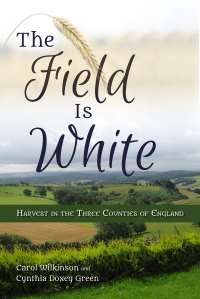From Then Until Now
Carol Wilkinson and Cynthia Doxey Green
Carol Wilkinson and Cynthia Doxey Green, “From Then until Now,” in The Field Is White, Carol Wilkinson and Cynthia Doxey Green (Provo, UT: Religious Studies Center; Salt Lake City: Deseret Book, 2017), 173-200.
Our focus so far in this book has been on the history of the Church in the Three Counties in the mid-1800s. This final chapter shifts focus to the situation of the Latter-day Saints in these counties from that time until the present, including ways members have connected with past events. To better demonstrate those connections, we offer a brief background of events that occurred in Britain in these intervening years.
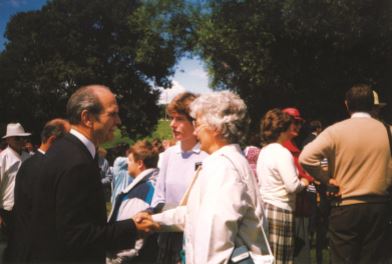 The dedication of Hill Farm pond by Elder Russell M. Nelson at the Sesquicentennial celebrations in 1987. (Photo by Carol Wilkinson.)
The dedication of Hill Farm pond by Elder Russell M. Nelson at the Sesquicentennial celebrations in 1987. (Photo by Carol Wilkinson.)
The Interim Period
Between 1840 and 1900, many British Saints emigrated to the United States. Starting in the 1880s, deep prejudices against the Church developed in England as former Church member William Jarman was delivering anti-Church lectures. A calm period followed the 1890 manifesto, which officially ended polygamy. But during the period from 1910 to 1914, various ministers and former LDS members mounted another anti-Church campaign, claiming that the missionary program was a front to enslave British girls and take them to the United States as polygamous wives. After World War I, this campaign influenced politicians, who subsequently denied the Church’s application for missionary visas. However, appeals from Utah’s congressional delegation were successful, and in 1920, American missionaries were once again on British soil.[1]
Seventeen years later in 1937, President Heber J. Grant and other Church leaders from the States joined local leaders to celebrate the centennial of the Church in the British Isles. During the first one hundred years, 126,593 persons had been baptized, and 52,000 of those had emigrated to the United States. During two weeks of festivities, President Grant dedicated chapels in Burnley, Bradford, Rochdale, Merthyr Tydfil, Liverpool, Southwest London, and North London. Two years later, World War II began, and American missionaries were evacuated, leaving local members to perform missionary work.[2]
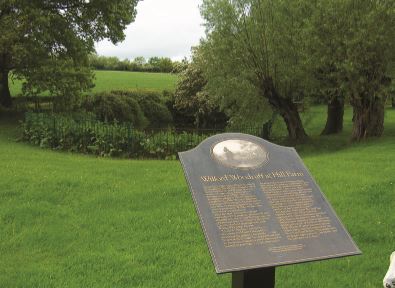 Hill Farm pond marker places in 1987 at the place where Wilford Woodruff first performed baptisms. (Photo by Cynthia Doxey Green.)
Hill Farm pond marker places in 1987 at the place where Wilford Woodruff first performed baptisms. (Photo by Cynthia Doxey Green.)
After the war, plans and construction began on a temple south of London, and on 7–9 September 1958, approximately 12,000 members attended the dedication services of the London Temple, conducted by President David O. MacKay. Two years later, on 17 June 1960, the Manchester Stake became the first stake in England. During the early 1960s, the Church called building missionaries and began a program to construct several meetinghouses. The Cheltenham chapel, dedicated on 13 December 1964, was the first in the Three Counties area.[3] On 21 March 1982, this chapel became the home of the new Cheltenham Stake. In 2015, this stake consisted of the Cheltenham, Gloucester, Hereford, Stroud, Swindon, Worcester, and Yate Wards and the Evesham and Forest of Dean branches.
Three Counties Connections with the Past
Sesquicentennial Celebrations. From 24–26 July 1987, along with other Latter-day Saints throughout the British Isles, Church members in Herefordshire, Worcestershire, and Gloucestershire commemorated the 150th anniversary of the first missionaries’ arrival in England. The British Isles Advisory Committee had three objectives for the Sesquicentennial celebrations:
Objective 1: To create a greater public awareness of the Church and, in particular, its British dimension.
Objective 2: To bring about a greater interest in the Church and encourage vigorous and productive missionary and member-missionary activity.
Objective 3: To stimulate a pride in the Church and Church history in British Latter-day Saints.[4]
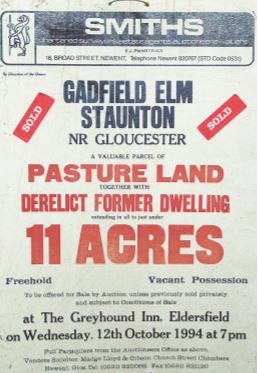 Gadfield Elm auction poster. (Courtesy of Gadfield Elm Chapel.)
Gadfield Elm auction poster. (Courtesy of Gadfield Elm Chapel.)
As part of the celebrations, in 1987 a history of the Church of Jesus Christ of Latter-day Saints in the British Isles titled Truth Will Prevail was published by University Press, Cambridge. British Saints involved in the organization of the celebratory events felt strongly that to reach the market of the British public, the book should be published in Britain.[5] In addition, James and Lavelle Moss wrote a guidebook to historic sites in Britain,[6] and Church leaders gathered oral histories of British members of the Church.[7]
Six regional conferences took place throughout the British Isles, including one in Cardiff. The Church had purchased a small piece of land at Hill Farm, where John Benbow had lived, and erected a public marker commemorating Wilford Woodruff’s mission in the Three Counties; Elder Russell M. Nelson dedicated this memorial on 25 July 1987. The land includes the area around the pond where Wilford Woodruff baptized so many people, along with a walking path from the parking site.
Among the celebrations, a British musical with the title of the new book Truth Will Prevail was performed in Bristol during 1987. The Church also produced A Story of Strength, a video which portrayed the early missionary exploits of Wilford Woodruff in the Three Counties area. Many local Church members participated as extras in the film. During this celebratory year, “Harvest in Herefordshire,” an article chronicling the early missionary success, was published in the January 1987 Ensign.
Restoration of the Gadfield Elm Chapel. The Gadfield Elm chapel was sold in 1842 to provide funds to help the new British converts emigrate to America. Neglect over the next 152 years made it an unsightly ruin. Prior to the celebrations in 1987, Elder Neal A. Maxwell had looked into the possibility of the Church’s purchasing the old Gadfield Elm chapel but felt the asking price was too high.[8] Over the years it was occasionally used as a shelter for farm animals, but in 1994 the land and chapel came up for sale at an auction.
Noticing the auction poster, Wayne Gardner, a local member of the Church, approached another member, Simon Gibson, and the two of them discussed the idea of purchasing the property. One dark night in the pouring rain, Wayne and Simon drove out to visit the dilapidated building to decide whether to buy it. Surveying the appalling condition of the ruin, which had only three intact walls and a mature tree growing in the middle of what structure remained, Simon had the feeling that the building was beyond repair. Then he had the following experience:
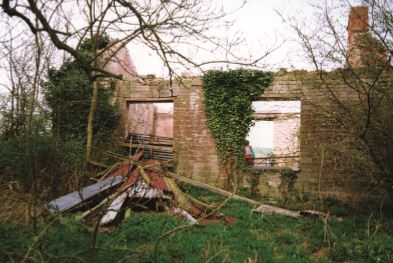 Gadfield Elm Chapel ruin. (Photo by Alec Mitchell.)
Gadfield Elm Chapel ruin. (Photo by Alec Mitchell.)
It was pitch black. . . . Wayne left me in there and I remember thinking, “This is beyond repair.” And I must admit I just stood there in the pouring rain and I did have this spiritual prompting, no doubt about that at all, telling me, “Do it.” Yes, definitely. Because I didn’t have the time or the inclination to really want to do it. And I remember all I could visualize in my mind was Wilford Woodruff’s eyes. Have you ever seen his eyes? Oh, I just saw those eyes and then I thought of Brigham Young. . . . Once I’d had that spiritual witness that I needed to do it, I thought, “There’s no way I’m going into the next life not having done it and have to face those two very formidable gentlemen.” . . . That’s exactly what it was. I could visualize it. I mean it was just like there’s no way I’m not doing this now. I’ve got to do it because I think it would be important to those men and to the Church.
So there I was standing in the pouring rain and then I got back into the car absolutely soaked. As I sat in the car I thought, “At least the fireplace was intact . . . so you could imagine where the lectern had been.” And I thought, “This has got to be the only place, certainly the only place I could think of in Europe, where you could, once it was restored, bring youth to. . . . They could sit in that chapel and you could say, “On this spot Brigham Young, Wilford Woodruff and Willard Richards all preached the message of the restored gospel.” This one spot could act as a focal point for this wonderful story. And I thought that would be a big deal for a lot of people, imagine holding a testimony meeting here and inviting the kids to bear their testimonies on the same spot that Wilford Woodruff and Brigham Young testified to those people. You know it would be powerful, which is what is happening right now.[9]
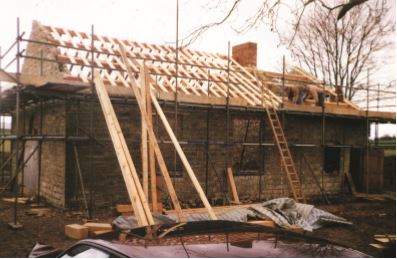 Reconstruction on Gadfield Elm Chapel. (Photo by Wayne Gardner.)
Reconstruction on Gadfield Elm Chapel. (Photo by Wayne Gardner.)
A group of local members got together and came up with sufficient money to purchase the chapel at the auction.[10] Stones were missing from the chapel, but only a few yards away lay a dilapidated barn built of stone from the same time period and the same quarry, so the members purchased some of that stone from the owner of the barn. Work on rebuilding the chapel began immediately.[11] When the walls were up, Church headquarters made a donation to help pay for a new roof. To provide sufficient financial aid for the project, members created the Gadfield Elm Trust. The aims of the Trust were (1) to preserve the chapel, (2) to restore the chapel to its former nineteenth-century condition when occupied by the early Latter-day Saints, (3) to raise awareness of nineteenth-century LDS history in the British Isles, and (4) to create a recreational site for public use.[12] The Trust obtained some pews from a non-conformist chapel in Wales that had been built during the same time period as the original Gadfield Elm chapel. Restoring the old well outside provided the chapel’s new water supply. The restoration was completed in time for the new millennium.[13]
During the time the chapel was being restored, local saints held a Church pageant in June 1995 to commemorate the 155th anniversary of the first conference in the British Isles at the first LDS chapel in Britain. Local members in period costumes represented Thomas Kington, Willard Richards, Wilford Woodruff and others as they reenacted the conference.[14] During this time the Gadfield Elm Trust began to produce literature to help educate the public.
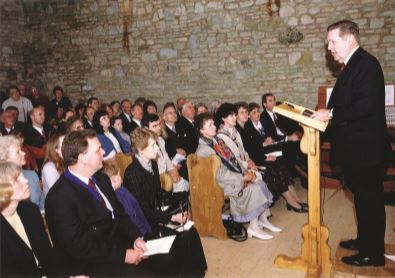 Elder Jeffery R. Holland speaking at the dedication of the restored Gadfield Elm Chapel in 2000. (Photo by Gerry Matthews.)
Elder Jeffery R. Holland speaking at the dedication of the restored Gadfield Elm Chapel in 2000. (Photo by Gerry Matthews.)
The Gadfield Elm chapel was rededicated on 23 April 2000, by Elder Jeffrey R. Holland of the Quorum of the Twelve, who had direct ancestors from the area: Ellen Benbow Carter from Castle Froome and William Carter of Ledbury. Elder Holland had been an area president for the area fifteen years earlier and was delighted to be involved. He described the circumstances leading to his presence that day:
I’m supposed to be today in Fukouka, Japan, with President Hinckley starting the first of four temple dedications that would have taken us from Fukuoka, Japan, to Adelaide, to Melbourne, Australia, to Suva, Fiji and a quick side trip to Bangkok, Thailand (laughs). Those are his [President Hinckley’s] kind of side trips. That’s where I’m supposed to be today. But in the broken-hearted prayers of the night when I said, “Surely, surely they won’t dedicate Gadfield Elm without me,” suddenly there was a strike in Adelaide and all temple dedications were put on hold for a month. And President Hinckley said, “Well you might as well go to England.” And don’t tell me that prayers of children and apostles aren’t answered.[15]
The members of the Gadfield Elm Trust felt that should the Church leaders wish to take ownership of the chapel, they would donate it. In 2004 the Church accepted the offer, and on 26 May 2004, President Gordon B. Hinckley received the keys and deed of the chapel and planted an oak tree to commemorate the occasion. The building, which now contains historic displays and literature informing visitors of the history of the Church in this area, is used for special events such as firesides, Relief Society meetings, and seminary graduations. People are allowed to camp on the property next to the chapel, allowing youth groups and families to travel and learn about the history of the area.[16]
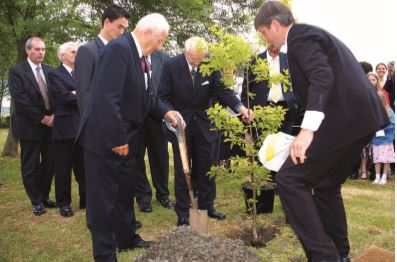 President Gordon B. Hinckley plants an oak tree at Gadfield Elm in 2004 after the chapel is donated to the Church by members of the Gadfield Elm Trust. Left to right, Simon Gibson, Brian Bliss, Craig Gardner, Peter Gardner, President Hinckley, Wayne Gardner, Cheryl Gardner (Background). (Photo by Gerry Matthews.)
President Gordon B. Hinckley plants an oak tree at Gadfield Elm in 2004 after the chapel is donated to the Church by members of the Gadfield Elm Trust. Left to right, Simon Gibson, Brian Bliss, Craig Gardner, Peter Gardner, President Hinckley, Wayne Gardner, Cheryl Gardner (Background). (Photo by Gerry Matthews.)
Other Significant Events. Local Church members in the Three Counties have engaged in a number of activities that connect them to the history of the Church in the United States. In 1997 local Church members received media coverage as they dressed in pioneer clothing and trekked the six miles from Ledbury to Dymock to mark the passing of 150 years since the arrival of Mormon pioneers in the Salt Lake Valley in 1847.[17] In 2002 the local Ledbury and District Historical Society published a booklet titled The Mormons in the Three Counties, 1840 to create interest in the Mormon role in their local history including its link with the pioneer days of the United States. In 2005, local Church members pulled handcarts from Malvern town center up Worcestershire Beacon to celebrate the 175th anniversary of the founding of the Church.
Several types of connections were involved with an event that occurred from 4 to 11 August 2011, when Saints from the Cheltenham Stake traveled to Salt Lake City and joined with members of the Salt Lake Glenmoor stake to perform Faith: The Musical at the LDS Conference Center. The play was written by David Markham of the Cheltenham Stake, who had written Truth Will Prevail in 1987. It follows the story of the Thomas Oakey family, baptized by Wilford Woodruff in 1840, including the family’s journey of faith to America, where they suffered great deprivation and death while crossing the plains with the ill-fated Willie handcart company before finally arriving in Salt Lake City.[18]
Some more recent events have focused specifically on the work of Wilford Woodruff and on the Benbow family. From 31 July to 10 August 2013, over 300 Church volunteers performed in The British Pageant in Chorley, on the Preston England Temple grounds in a large marquee that seated 1,500.[19] Part of the pageant chronicled the 1840 conversion of John and Jane Benbow and Ellen Benbow Carter to the message of the gospel restoration.[20] In 2015 local members of the Cheltenham Stake congregated at Gadfield Elm chapel and celebrated the 175th anniversary of the June 1840 conference that was held in the chapel establishing the organization of the Church in that area. The celebration consisted of a dramatic retelling of the events of Wilford Woodruff’s mission to the Three Counties area.[21]

Historic Sites
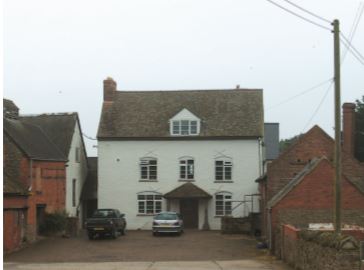 Current Entrance to Hill Farm, Herefordshire, where John and Jane Benbow lived. (Photo by Carol Wilkinson.)
Current Entrance to Hill Farm, Herefordshire, where John and Jane Benbow lived. (Photo by Carol Wilkinson.)
Sites of important events of early Church history in the Three Counties link Church members and other interested people of the twenty-first century to their nineteenth-century roots. The remainder of this chapter will focus on these locations of so much Church progress and individual member and missionary growth. We hope this will be useful in providing geographical and historical contexts, especially for people desiring to visit the area.
Hill Farm and Pond. As discussed in chapter 3, Wilford Woodruff arrived at Hill Farm in March 1840 in company with William Benbow. William introduced Elder Woodruff to his brother John Benbow and his wife Jane, who were tenant farmers at Hill Farm. Two days later John, Jane, and three of their friends were baptized in the pond on the farm. On the following Sunday, Elder Woodruff preached three sermons in three different locations to a combined total of almost one thousand people. The last sermon was preached at the Benbow’s home.[22] This sermon may have been preached in an attached barn, as this was the only building on the farm that could accommodate a large number of people. During the next few weeks, Elder Woodruff preached in the area, and many converts were baptized in the pond.
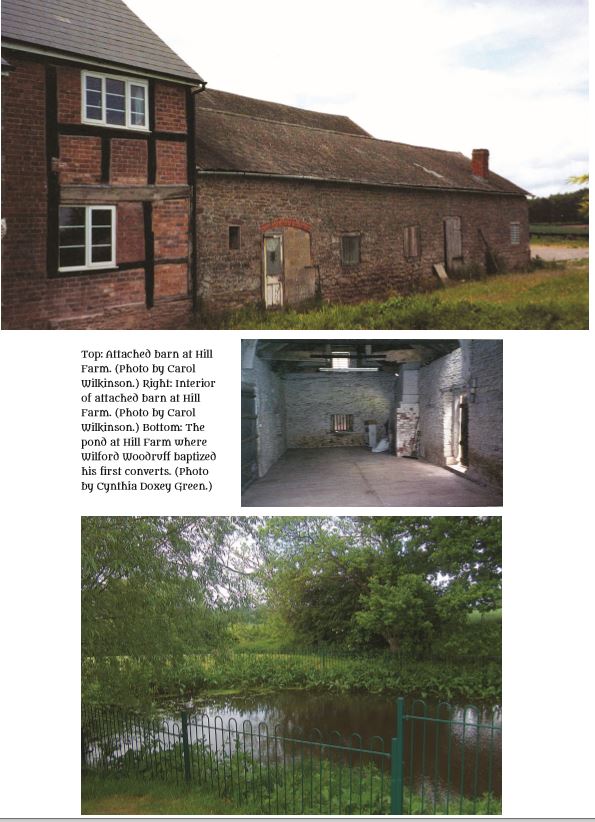
Castle Frome Church. On the Sunday following the baptisms of John and Jane Benbow, the local parish rector of the church in Castle Frome, being disconcerted at the numbers attending two sermons preached earlier that day, sent a constable to Hill Farm with a warrant to arrest Elder Woodruff before his final address. The constable agreed to let Elder Woodruff preach before making the arrest, but he was so moved by the teaching of Elder Woodruff that he was converted. Two parish clerks attending another sermon were similarly touched and also requested baptism.
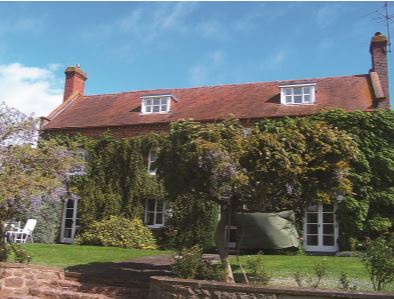 Moorend Farm was the home of Edward Ockey, a member of the United Brethern. (Photo by Cynthia Doxey Green.)
Moorend Farm was the home of Edward Ockey, a member of the United Brethern. (Photo by Cynthia Doxey Green.)
Moorend Farm. Moorend Farm was the home of Edward Ockey, a member of the United Brethren and a friend of John Benbow. He sold all of his stock and property in March 1841 to provide money so that he and other Church members could emigrate to America.[23]
Dymock. Thomas Kington, the superintendent of the United Brethren, lived in Dymock. In this village on 18 May 1840, Mary Pitt, who had not walked without crutches for eleven years and had been confined to bed for six years, was healed of her infirmity by a blessing from Brigham Young, Wilford Woodruff, and Willard Richards.[24] By September, opposition to the Church was mounting, and as Elder Woodruff preached in Dymock, a mob pelted the home with anything they could lay their hands on. They smashed windows and roof tiles, creating a raucous noise to attempt to stop the sermon, which they were not able to do.[25]
Ledbury. The market town of Ledbury was a base for the missionaries in 1840. Brigham Young stayed there for a week. Wilford Woodruff was approached by the minister of the Baptist Church in Ledbury and invited to preach in the chapel. As a result of Elder Woodruff’s preaching, several members of the congregation were baptized in the font of the chapel.[26]
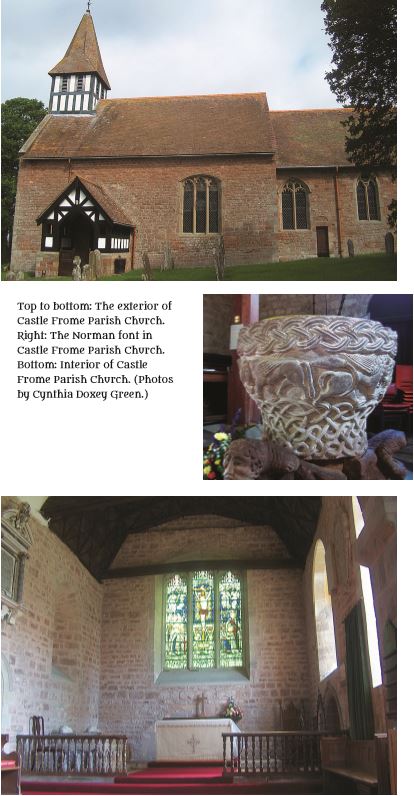
Gadfield Elm Chapel. On 4 March 1836, two of the United Brethren, Thomas Kington and John Benbow, both of the parish of Castle Froome, purchased the land known at the time as Gatfields Elm in the parish of Eldersfield for the sum of twenty five pounds, for a chapel for the use of the Society of the United Brethren.[27] In 1840, Elders Woodruff, Young, and Richards all spoke in the chapel and conducted conferences there. In September of 1840, former members of the United Brethren who had since joined the Church gave the Gadfield Elm chapel to The Church of Jesus Christ of Latter-day Saints. It was the first chapel the Church could claim title to in Britain. In 1842, the chapel was sold to help finance emigration of Church members to America.[28] As the decades passed, the building fell into disrepair, until it was purchased and restored by local Church members in 1994 and given to the Church in 2004. (See description of the purchase and restoration of Gadfield Elm chapel earlier in this chapter.)
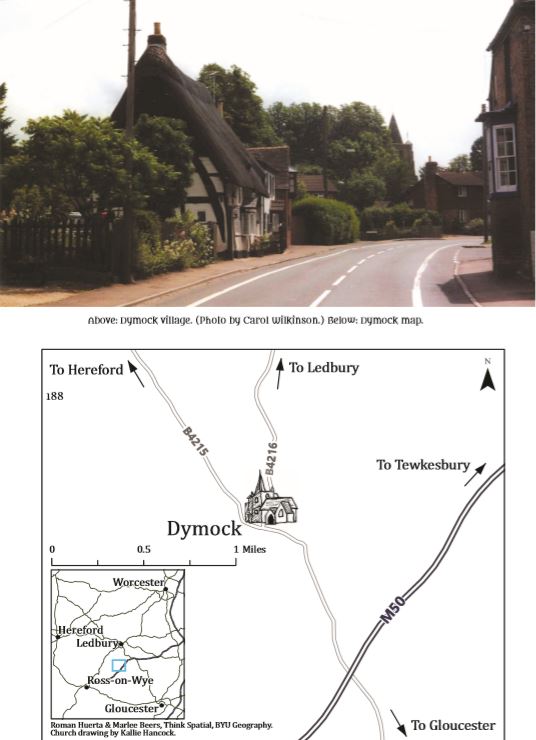
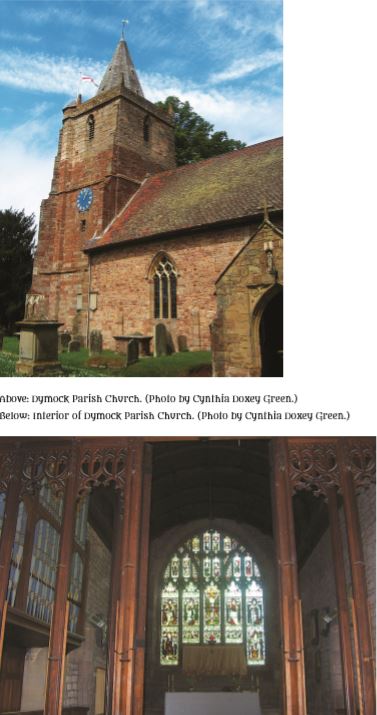

 Covered Marketplace in Ledbury. (Photo by Cynthia Wilkinson.)
Covered Marketplace in Ledbury. (Photo by Cynthia Wilkinson.)
Hawcross. William Symmons was a member of the United Brethren who lived in Hawcross. On 8 April 1840, Wilford Woodruff and Thomas Kington preached at his home, and after the meeting, many requested baptism. As a “body of water [was] situated at the bottom of the garden,” they got ready, assembled there, and the baptisms began. However, a group of individuals began to throw stones at Elder Woodruff, several of them striking him, so that the remainder of the baptisms had to be deferred. On this occasion, Job Smith received direct confirmation from Wilford Woodruff that the latter was an Apostle and had the authority to baptize. Job was later baptized by Thomas Kington on 18 May 1840, in Dymock.[29]
Currently there is no pond situated at the bottom of the garden of William Symmons’s home on Hawcross Lane, but early maps show several small ponds near where William Symmons lived. Baptisms might have taken place in the above pond, which is situated on Hawcross Lane approximately 300 meters west of the junction with Innerstone Lane, next to the road on the right hand side. It is on private property, but is visible from the road.
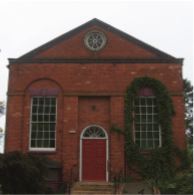 Ledbury Baptist chapel. (Photo by Cynthia Doxey Green.)
Ledbury Baptist chapel. (Photo by Cynthia Doxey Green.)
Herefordshire Beacon. This hill, part of the Malvern Hills area, was the site of an Iron Age hill fort (as shown in the photograph). Elder Woodruff would often retire here to contemplate the work of the restoration. On 20 May 1840, he went to Herefordshire Beacon accompanied by Brigham Young and Willard Richards; after they held a meeting, they decided to publish the Book of Mormon and a hymnbook in England. Brigham Young immediately traveled to Manchester to start the publications. Both John Benbow and Thomas Kington made financial contributions to help in accomplishing this goal.[30]
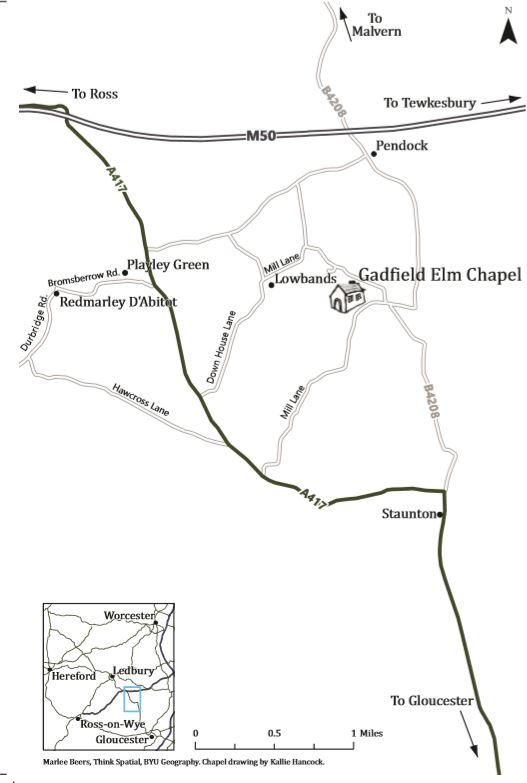
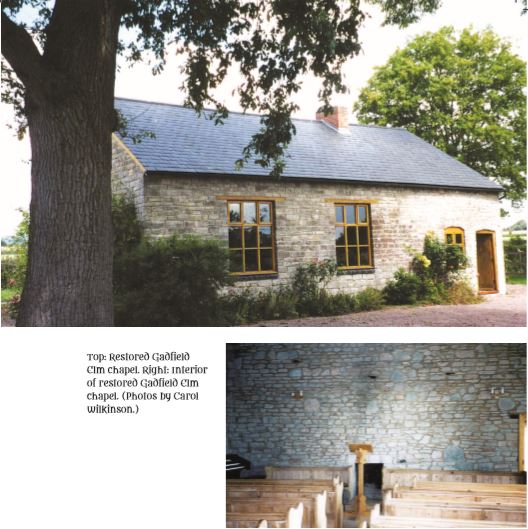
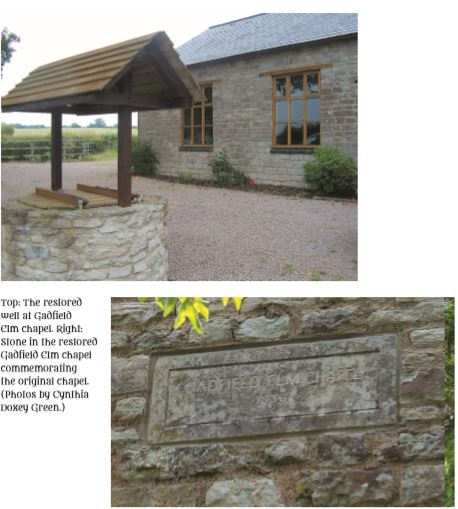
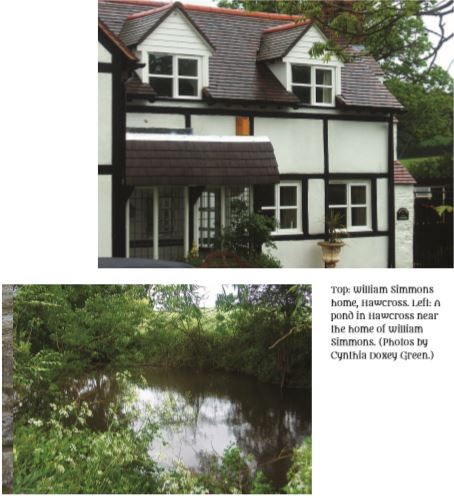


Conclusion
The historical events described in this book have shown that when Wilford Woodruff arrived at Hill Farm in March 1840, the ground had been prepared and the field was white, ready for the great harvest of souls that took place over the next few years. In addition to the missionary work of Elder Woodruff, other Apostles and missionaries labored in this critical endeavor to bring the message of the restored gospel to a people seeking further light and knowledge.
While records are inconsistent and incomplete, from the available information we know that many converts emigrated to the United States soon after baptism while others stayed behind for a time. Of those who did not leave with the early groups, some eventually emigrated, and others remained in England. As with any group of people who experience change, some converts remained faithful to their newfound beliefs and some drifted away from the Church. Wilford Woodruff called particular attention to the faithfulness of the converts who went to America. The events of this time of great harvest have provided a legacy for local Church members from the Three Counties, often joined by members from across England and across oceans, to engage in a variety of performances and activities to remind themselves and others of the roots of the kingdom they are continuing to build today.
Notes
[1] “Country Information: United Kingdom,” Church News, 1 February 2010.
[2] “Country Information: United Kingdom,” Church News, 1 February 2010.
[3] “Country Information: United Kingdom,” Church News, 1 February 2010; “A Heritage of Love: An Account of the History of the Church of Jesus Christ of Latter-day Saints in the Cheltenham, England Stake, Written and Researched by Members of the Cheltenham Stake, ed. Jennifer Mason,” M274.2 C516c 1987, Church History Library, Salt Lake City, 24.
[4] 1987 British Sesquicentennial Celebrations: Report of the British Isles Advisory Committee, March 1985, Office of the Europe Area Presidency, 4.
[5] V. Ben Bloxham, to James R. Moss, 21 March 1986.
[6] James Moss and Lavelle Moss, Historic Sites of The Church of Jesus Christ of Latter-day Saints in the British Isles (Salt Lake City: Publishers Press, 1987).
[7] David Cook, personal communication, Solihull, England, 2006.
[8] Wayne Gardner, interview by Carol Wilkinson, 31 May 2005, Gloucestershire, England, in author’s possession.
[9] Simon Gibson, interview by Carol Wilkinson, 13 September 2006, Monmouth, in author’s possession.
[10] Carol Wilkinson, “The Restoration of the Gadfield Elm Chapel,” in Regional Studies in Latter-day Saint Church History: The British Isles, ed. Cynthia Doxey, Robert C. Freeman, Richard Neitzel Holzafel, and Dennis A. Wright (Provo, UT: Religious Studies Center, 2007), 48–51.
[11] Wayne Gardner, personal communication, 31 May 2005, Gloucestershire, England.
[12] The Gadfield Elm Trust, “The Gadfield Elm Trust” (brochure, 1996).
[13] Simon Gibson, interview by Carol Wilkinson, 11 August 2005.
[14] Head, R. J. “Creating a Mormon Mecca in England: The Gadfield Elm Chapel,” Mormon Historial Studies 7, no. 1–2 (2006): 93–94.
[15] Jeffrey R. Holland, address at dedication of Gadfield Elm chapel, 23 April 2000, videotape in possession of author Carol Wilkinson, transcribed by Carol Wilkinson.
[16] Wilkinson, “The Restoration of the Gadfield Elm Chapel,” 55–57.
[17] England Bristol Mission Alumni Website, http://
[18] Joseph Walker, “English, U.S. Mormons join forces to create ‘Faith,’” Deseret News, 3 August 2011.
[19] “Truth Will Prevail! UK Mormons Honour British Heritage in The British Pageant,” http://
[20] “British Pageant: Truth Will Prevail, ‘Character Bios,’” http://
[21] “Gadfield Elm at 175,” http://
[22] Allen, Esplin, and Whittaker, Men with a Mission, 124–25.
[23] “Moorend Farm, Castle Frome, Herefordshire, to Sell By Auction,” Hereford Times, 27 March 1841; Edward Ockey, “reminiscence and journal, (ca. 1857–58),” MS 11746, Church History Library, Salt Lake City, 1.
[24] Woodruff, Leaves from My Journal, 131–32.
[25] Allen, Esplin, and Whittaker, Men with a Mission, 199.
[26] Wilford Woodruff, “Elder Woodruff’s Letter [Concluded],” Times and Seasons 2, no. 9 (1 March 1841): 329.
[27] V. Ben Bloxham, “Deed of Conveyance Between Thomas Shipton (as Grantor) of the One Part and John Benbow and Thomas Kington (as Grantees) of the Other Part Dated 4 March 1836,” 9 October 1984, 1–2, transcript from a photographic copy of the copy in the Public Record Office, London.
[28] “The History of Gadfield Elm Chapel,” www.lds.org.uk/
[29] Job Taylor Smith, “Job Smith Autobiography, circa 1902,” 1–2, MS 4809, Church History Library, Salt Lake City.
[30] Allen, Esplin, and Whittaker, Men with a Mission, 151.
